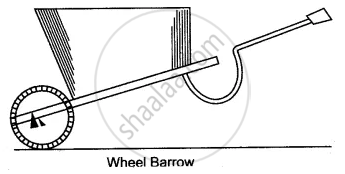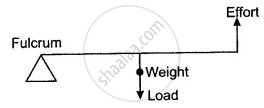Advertisements
Advertisements
प्रश्न
A lever of length 9 cm has its load arm 5 cm long and the effort arm is 9 cm long.
- To which class does it belong?
- Draw a diagram of the lever showing the position of fulcrum F and directions of both the load L and effort E.
- What is the mechanical advantage and velocity ratio if the efficiency is 100%?
- What will be the mechanical advantage and velocity ratio if the efficiency becomes 50%?
उत्तर
- The length of the lever is the same as the effort arm. Also, an effort arm is more than a load arm. So, this is a class II lever.

-
Mechanical advantage is
M.A. = `"effort arm"/"load arm" = (9 "cm")/(5 "cm")`
= 1.8
The relationship between MA, efficiency and V.R. is
M.A. = η × V.R.
V.R. = `(M.A)/η`V.R. = `(1.8 xx 100)/100`
V.R. = 1.8
-
When efficiency becomes 50%, i.e.,
`50/100 = 1/2`
M.A. < V.R.
Then V.R. will remain same 1.8
but its M.A. will become
M.A. = V.R. × η
M.A. = `(1.8 xx 50)/100 = 0.9`
APPEARS IN
संबंधित प्रश्न
Draw a diagram of a lever which is always used as a force multiplier. How is the effort arm related to the load arm in such a lever?
A man uses a crowbar of length 1.5 m to raise a load of 75 kgf by putting a sharp edge below the bar at a distance 1 m from his hand.
- Draw a diagram of the arrangement showing the fulcrum (F), load (L) and effort (E) with their directions.
- State the kind of lever.
- Calculate:
- load arm,
- effort arm,
- mechanical advantage and
- the effort needed.
Which type of levers have mechanical advantage always more than 1? Give reasons.
Give three examples for leavers of the third order.
Which class of lever found in the human body is being used by a boy when he holds a load on the palm of his hand.
The following belong to which class of lever?
Human-arm
The following belong to which class of lever?
Rowing of a boat
The following belong to which class of lever?
Knife
In the following diagram of a wheelbarrow, mark the fulcrum (F) and indicate the directions of load (L) and effort (E) with arrows.

What class of lever is it? Give one more example of the same class of lever.
When we want to use a machine as a force multiplier, which class of lever should we preferably use? Give a simple diagram of such a lever.

